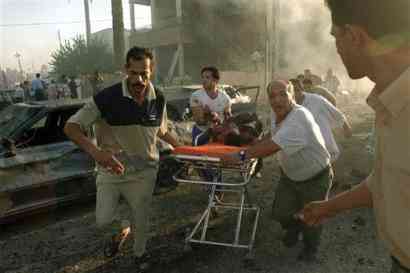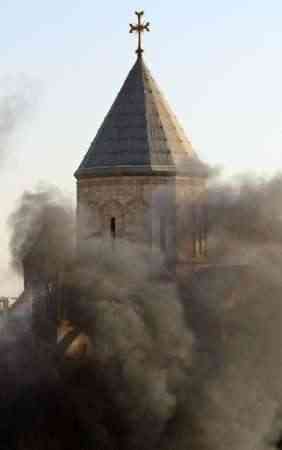

 (AINA) -- Less than one week after the deadly Assyrian Church bombings in Baghdad and Mosul (photo gallery), Iraq, Assyrians once again will gather to commemorate Assyrian Martyr's Day. August 7 marks the memorial day for legions of Assyrian (also known as Chaldeans and Syriacs) victims of massacres, pogroms, and genocide in general, but in particular commemorates the fateful day in 1933 when the newly established Iraqi army massacred upwards of 3000 Assyrian civilians in and around Simmele, Northern Iraq (account of the massacre). This year's Church bombings coinciding with the 71st anniversary of the massacre have rekindled the same Assyrian concerns about security in Iraq and reignited calls for a "Safe Haven" in an Assyrian administered area.
(AINA) -- Less than one week after the deadly Assyrian Church bombings in Baghdad and Mosul (photo gallery), Iraq, Assyrians once again will gather to commemorate Assyrian Martyr's Day. August 7 marks the memorial day for legions of Assyrian (also known as Chaldeans and Syriacs) victims of massacres, pogroms, and genocide in general, but in particular commemorates the fateful day in 1933 when the newly established Iraqi army massacred upwards of 3000 Assyrian civilians in and around Simmele, Northern Iraq (account of the massacre). This year's Church bombings coinciding with the 71st anniversary of the massacre have rekindled the same Assyrian concerns about security in Iraq and reignited calls for a "Safe Haven" in an Assyrian administered area.
In the early stages of the last century, Great Britain enlisted the support of the Assyrians as an ally in World War One. The autonomous Assyrians were drawn into the conflict following successive massacres against the civilian population by forces of the Ottoman Empire consisting of Turks and Kurds. Although many geopolitical and economic factors were involved in provoking the attacks against the Assyrians, a jihad or "holy war" was declared and served as the rallying cry and vehicle for marauding Turks, Kurds, and Persians. Although the Muslim holy war against the Armenians is perhaps better known, over three-fourths, or 750,000 Assyrian Christians died by outright murder, starvation, disease and the all too familiar consequences of genocide, between 1914-1923 during the Assyrian Holocaust along with a significant number of Pontic Greeks.
 The conflict and subsequent Assyrian Holocaust, commemorated on April 24 of every year as Sayfo ("The Sword"), led to the decimation and dispersal of the Assyrians. Those Assyrians who survived Sayfo were driven out of their ancestral homeland in Turkish Mesopotamia primarily toward the area of Mosul Vilayet in Iraq, Jazira in Syria, and the Urmi plains of Iran where large Assyrian populations already lived. The massacres of 1915 followed the Assyrians to these areas as well, prompting an exodus of many more Assyrians to other countries and continents. The Assyrian Holocaust of 1915 is the turning point in the modern history of the Assyrian Christians precisely because it is the single event that led to the dispersal of the surviving community into small, weak, and destitute pockets.
The conflict and subsequent Assyrian Holocaust, commemorated on April 24 of every year as Sayfo ("The Sword"), led to the decimation and dispersal of the Assyrians. Those Assyrians who survived Sayfo were driven out of their ancestral homeland in Turkish Mesopotamia primarily toward the area of Mosul Vilayet in Iraq, Jazira in Syria, and the Urmi plains of Iran where large Assyrian populations already lived. The massacres of 1915 followed the Assyrians to these areas as well, prompting an exodus of many more Assyrians to other countries and continents. The Assyrian Holocaust of 1915 is the turning point in the modern history of the Assyrian Christians precisely because it is the single event that led to the dispersal of the surviving community into small, weak, and destitute pockets.
On account of the Assyrians siding with the victorious Allies during World War One, Great Britain had promised the Assyrians autonomy, independence, and a homeland in order to ensure their security and survival. The Assyrian question was addressed during postwar deliberations at the League of Nations. However, with the termination of the British Mandate in Iraq, the unresolved status of the Assyrians was relinquished to the Iraqi government with certain minority guarantees specifically concerning freedom of religious, cultural, and linguistic expression.
Many of the Assyrians surviving Sayfo had been gathered in refugee camps in Iraq pending final resettlement in an autonomous Assyrian homeland. In 1933, however, the Iraqi government declared an ultimatum giving the Assyrians one of two choices: either to be resettled in small populations dispersed amongst larger Muslim populations that had recently been violently antagonistic or to leave Iraq entirely. Some Assyrians chose to leave to neighboring Syria and so notified the Iraqi government of their intention. In response, the Iraqi government dispatched the Iraqi army to attack the Assyrians fleeing into Syria. In their subsequent defeat, the retreating Iraqi army massacred over 3,000 Assyrian civilians in Simmele and other surrounding towns in northern Iraq in August of 1933. Eyewitness accounts recorded babies hurled into the air and bayoneted and women and elderly being run over by vehicles repeatedly. Upon his return to Baghdad, the commanding officer, a Kurd named Bekir Sidqi, who executed the massacre was hailed as a conquering hero. Thus, the first official military campaign of the Iraqi army served as the newly independent government's final solution to the Assyrian question. The demoralized Assyrian refugee population in Iraq was thereby resettled in dispersed villages while the other surviving isolated communities languished in the areas of Tur Abdin, Turkey; Jazira, Syria; and Urmi, Iran.
The lessons of World War I and 1933 remain fresh in the Assyrian psyche. On the one hand, deep apprehension about the peaceful intentions of their neighbors is coupled with profound suspicion about the reliability and commitment of Western powers. These same lessons were re-inscribed into the Assyrian psyche on August 1, 2004 as old wounds were once again torn open.
For Assyrians, today's circumstances in Iraq mark striking similarities to those of 1933. Again today, Assyrians find themselves in a period of flux, insecurity, threat, and uncertainty. The official Assyrian political aspiration of an administered or semi-autonomous area in the Plains of Nineveh hark back to the appeals made to the League of Nations. The negligible commitment of the West to protect Assyrian Christians mirrors the neglect of the past as well. And now rising attacks against Assyrians1 climaxing in the bloody Church bombings rekindle the same Assyrian suspicions and apprehensions felt in August 1933 when Bekir Sidqi schemed to cleanse yet another region of Assyrians.
However, some welcome differences are not deniable either. Whereas in 1933, the government of Iraq marked the bayoneting of babies by Sidqi's henchmen with parades and medals, today's Iraqi government and leading Islamic leaders were quick to condemn the attacks. The rapidity of blaming the attacks on Jordanian born Zirqawi -- a non-Iraqi Al-Qaeda operative -- attempted to send a quick signal that this could not have been an inside Iraqi attack on fellow Iraqi Christians. One Assyrian analyst who welcomed the condemnations from across the Iraqi political and religious spectrum as a refreshing sea change, never the less viewed the quick declaration by the government that Zirqawi had orchestrated the attack as at least premature if not wholly disingenuous. "Clearly a non-Iraqi Al-Qaeda may have committed these attacks, but so too could have others such as Kurds, former Baathists or anyone else fighting US forces who may in their own twisted way link Assyrian Christian Churches to the American 'Christian' forces. For the government to quickly blame Zirqawi without an investigation or a claim of responsibility smacks of a political decision to absolve or whitewash -- as it were -- any Iraqi or Iraqi society itself for that matter of such a heinous crime. August 7, 1933 and the subsequent decades of persecution by successive regimes remind us that Iraq has been and indeed is capable of such acts. Sweeping such attacks under the rug will not serve the progress of Iraqi society due justice. The history of abuse and massacre of Assyrians by the Iraqi state must be recognized. Only when we come to terms with the historical facts and realities and accept the Assyrian people's aspiration to live in security in their ancestral towns and villages in the Nineveh Plain can we begin to lay Assyrian concerns to rest." On a hopeful note, the analyst noted "The early signs from Iraq with nearly universal condemnation of the attacks is indeed encouraging, however."
This year, less than one week after five Christian Churches were bombed, Assyrians will gather on August 7 in their Churches, social halls, and cemeteries for poems, prayers, and recollections (story). This year, armed with haunting images of smoke billowing from their churches, Assyrians will again become determined to rebuild and refortify. This year, Assyrians will couple the memories of the Simmele massacre with fresh images of bloodied and dead worshipers as they redouble their efforts to transform the historical dream of a self administered area into a safe, secure, and lasting reality.
1 Click here for information on the persecution of Assyrians: 1, 2, 3, 4, 5, 6, 7, 8, 9, 10, 11, 12. See also the following human rights reports: AINA Report on Assyrian Human Rights, Amnesty International report on Assyrian Human Rights.

or register to post a comment.